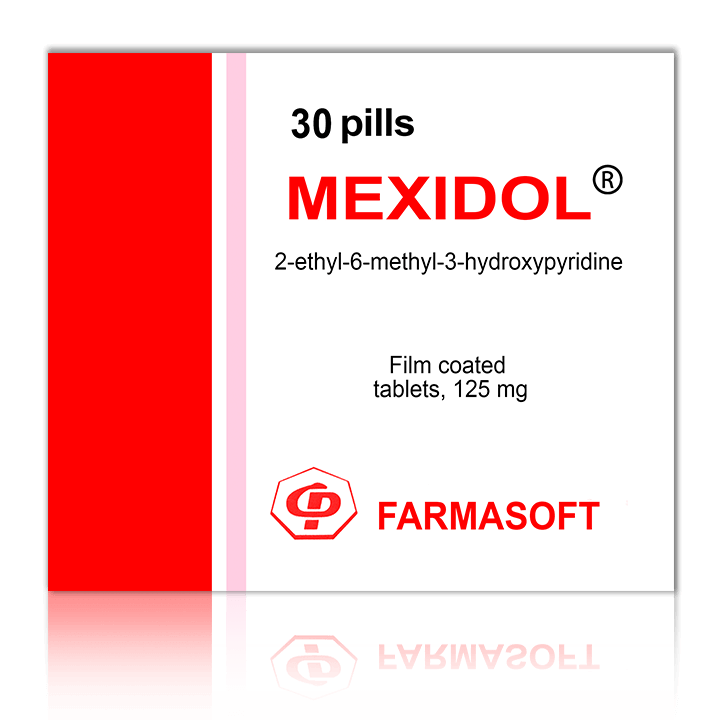Mexidol® (Emoxypine) Instruction
International Non-Proprietary Name (INN): mexidol (emoxypine)
Dosage form: pills (125 mg)
Structure
1 pill contains:
Active ingredient: ethylmethylhydroxypyridine succinate (2-ethyl-6-methyl-3-hydroxypyridine) – 125 mg;
Excipients: lactose monohydrate – 97.5 mg, povidone – 25 mg, magnesium stearate – 2.5 mg;
Film coat: opadrai II white 33G28435 – 7.5 mg (hypromellose 3 mg, titanium dioxide – 1.875 mg, lactose monohydrate – 1.575 mg, polyethylene glycol (macrogol) – 0.6 mg, triacetin – 0.45 mg).
Description
The double radius pills are covered with a film coat in white or light creamy color. On the cross-section, there are two layers: the inner one (the core) is gray or gray-creamy and the outer one is white or white-creamy.
Pharmacological classification: antioxidant
ATC code: N07XX
Pharmacological action: antioxidant, anxiolytic, antihypoxic, anticonvulsant, anti-ischemic, nootropic, neuroprotective, anti-inflammatory and cardioprotective

Pharmacodynamics
Mexidol® is an inhibitor of free-radical processes and membrane protector with antihypoxic, stress-protective, nootropic, anticonvulsant and anxiolytic action. The drug increases the resistance of the body to various damaging factors (shock, hypoxia, ischemia, cerebral circulation disorders, and intoxication with alcohol and antipsychotic drugs (neuroleptics)).
Mexidol® has antioxidant, antihypoxic, and membrane-protective action. It inhibits lipid peroxidation, increases the activity of superoxide dismutase, increases the lipid-protein ratio, reduces the viscosity of the membrane, and increases its fluidity. The drug modulates the activity of membrane-bound enzymes (calcium of independent phosphodiesterase, adenylate cyclase, and acetylcholinesterase) and receptor complexes (benzodiazepine, GABA, and acetylcholine): it enhances their ability to bind to ligands, helps to preserve the structural and functional organization of biomembranes and neurotransmitter transport, and facilitates synaptic transmission improvement.
Mexidol® causes an increase of dopamine in the brain. It enhances compensatory activation of aerobic glycolysis and weakens the inhibition of oxidative processes in the Krebs cycle under conditions of hypoxia with an increased ATP and creatine phosphate. The drug activates the energy-synthesizing functions of mitochondria and stabilization of cell membranes.
Mexidol® improves the metabolism and blood supply of the brain, improves microcirculation and rheological properties of blood, and reduces platelet aggregation. It stabilizes the membrane structures of blood cells (erythrocytes and platelets) during hemolysis. The drug has a hypolipidemic effect and lowers the level of total cholesterol and low-density lipoproteins.
Anti-stress action of the drug normalizes post-stress behavior and somatic-vegetative disorders, restores sleep-wake cycles, disrupted learning and memory processes, and reduces dystrophic and morphological changes in various structures of the brain.
Mexidol® has a pronounced antitoxic effect in patients with withdrawal syndrome. It eliminates neurological and neurotoxic manifestations of acute alcohol intoxication, restores behavioral disorders, vegetative functions, and is also capable of removing cognitive impairments caused by prolonged intake of ethanol and its discontinuation. Mexidol® enhances the effect of tranquilizers, neuroleptics, antidepressants, hypnotics, and anticonvulsants, so that it is possible to reduce their doses and diminish side effects. Mexidol® improves the functional state of the ischemic myocardium. In conditions of coronary insufficiency, the drug increases the collateral blood supply of the ischemic myocardium, preserves the integrity of cardiomyocytes, and maintains their functional activity. It restores effectively myocardial contractility with reversible cardiac dysfunction.
Pharmacokinetics
Cmax in plasma for the dosage of 400–500 mg is 3.5–4.0 μg / ml and is achieved within 0.45–0.5 hours. Mexidol® is quickly distributed in organs and tissues. The average retention time of the drug in the body is 4.9–5.2 hours. The drug is metabolized in the liver by glucuronconjugation. T1/2 is 2–2.6 hours. Mexidol® is excreted from the body with urine mainly in glucuronoconjugate form and in small amounts in unchanged form.
Intended uses
- consequences of acute cerebral circulation disorders, including after transient ischemic attacks, in the phase of subcompensation as a preventive measure;
- light craniocerebral injury, the consequences of craniocereberal trauma;
- encephalopathy of various genesis (dyscirculatory, dismetabolic, posttraumatic, mixed);
- vegetative dystonia syndrome;
- light cognitive disorders of atherosclerotic origin;
- anxiety disorders in neurotic and neurosis-like states;
- state after acute intoxication by antipsychotic drugs;
- asthenic conditions, and also to prevent the development of somatic diseases under the influence of extreme factors and loads;
- extreme (stress) factors impact;
- ischemic heart disease (as part of complex therapy);
- relief of alcohol withdrawal syndrome (predominance of neurosis-like and vegetative-vascular disorders), post-abstinence disorders.
Contraindications
Individual intolerance, acute renal failure, and acute hepatic failure. It is not recommended for children, pregnant and lactating ladies due to the lack of clinical research data.
Dosage and administration
Orally, 125–250 mg (1-2 pills) 3 times a day. The maximum daily dose is 800 mg (6 pills).
The duration of the standard treatment course is 2–6 weeks (for relief of alcohol withdrawal syndrome 5–7 days). Treatment should be finished gradually, reducing the dosage within 2-3 days.
The initial dosage is 125–250 mg (1-2 pills) 1-2 times a day with a gradual increase till a therapeutic effect is obtained; the maximum daily dose is 800 mg (6 pills).
Duration of the course of therapy in patients with IHD (ischemic heart disease) is at least 1.5–2 months. Repeated courses (on doctor’s recommendation) should be conducted preferably in the spring-autumn periods.
Side effects
Rare: Nausea, dry mouth, allergic reactions.
Overdose
Overdose may develop drowsiness.
Interaction with other drugs
Mexidol® can be combined with all drugs used to treat somatic diseases. It enhances the action of benzodiazepine derivatives, antidepressants, anxiolytics, antiparkinsonian, and anticonvulsants. Mexidol® reduces the toxic effect of ethanol.
Special instructions
In some cases (especially in predisposed patients with bronchial asthma and increased sensitivity to sulfites), severe hypersensitivity reactions can arise.
Pregnancy and lactation
Mexidol® is not recommended during pregnancy and lactation.
Influence on the ability to drive vehicles and operate mechanisms
During the treatment period, care must be taken when driving vehicles and engaging in other potentially hazardous activities that require increased concentration of attention and speed of psychomotor reactions.
Terms of release from pharmacy
On prescription.
Storage conditions
Store in a dry dark place at temperatures no higher than 25°C. Keep out of reach of children.
Shelf life
3 years. Do not use beyond the expiration date printed on the package.
Manufacturer
Pharmasoft, Russia. https://pharmasoft.ru/